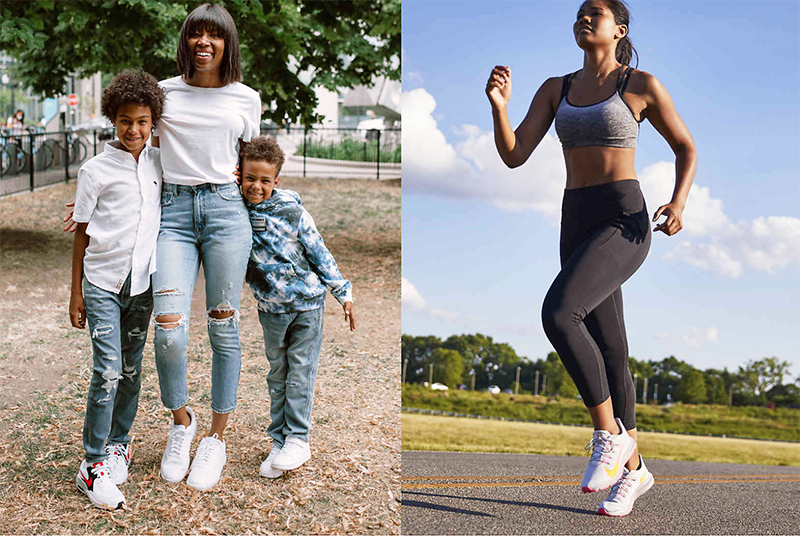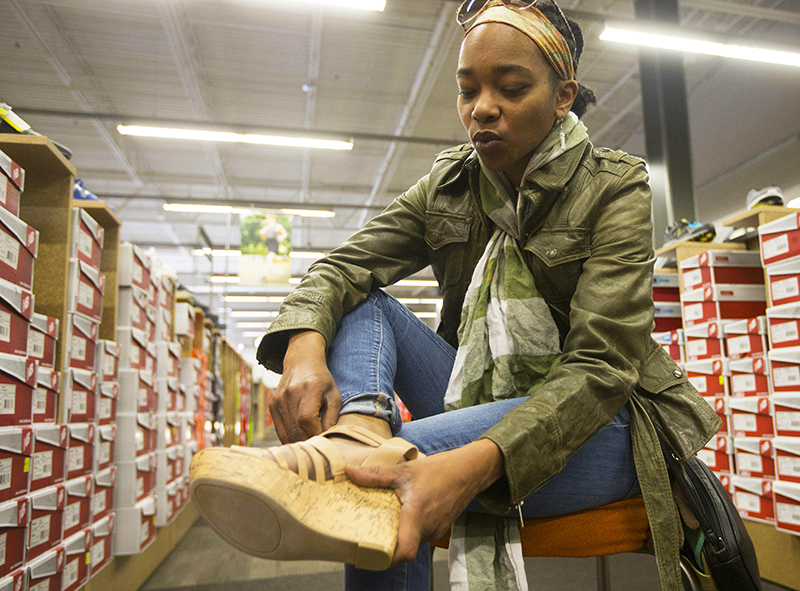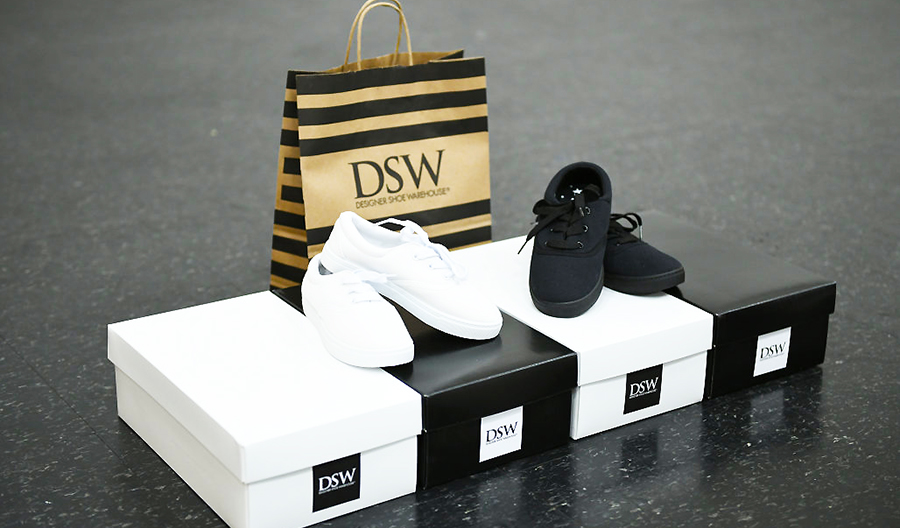By Thomas J. Ryan
<span style="color: #a3a3a3;">Designer Brands Inc. vowed to double-down on its efforts to expand their athletic assortment as its DSW off-price chain and its core dressier styles see meager traction from today’s stay-at-home consumer.
“Even with the steep markdowns we applied to traditional seasonal and dress, customers are strongly gravitating toward comfortable and casual looks, as they spend much of their time at home and engaged in outdoor leisure activities,” said Roger Rawlins, CEO at Designer Brands and interim president, DSW, on the company’s second-quarter conference call with analysts. “In response, we are flexing our agile business model and building our fall assortment to reflect consumer demand.”
In the second quarter, athletic comps at DSW were down 24 percent, significantly stronger than its overall store traffic, which was down 59 percent. Conversely, dress and seasonal comped negative 66 percent and negative 47 percent, respectively
Furthermore, Rawlins noted that DSW’s merchandise margin rates on non-athletic and non-kids business was in the teens in the quarter compared to the mid-40s last year. Conversely, the balance of the assortment was much more in line with what DSW had seen historically.
As a result, Rawlins said fall receipts have been modified away from traditional seasonal dress toward athleisure, DSW’s current highest performing category. He added, “Designer Brands has the flexibility and the necessary vendor relationships to become a go-to sneaker headquarters during this time.”
He noted that DSW already had expanded its athletic business to 24 percent of its mix at the end of the second quarter, up from 17 percent in 2019 as it has been placing a greater focus on the category in recent years. But he said the category remains“under penetration” and “we see a large market share opportunity ahead of us.”
Among its closest off-price footwear competitors, Shoe Carnival has the highest athletic mix, at 51 percent in fiscal 2019.
Dress and seasonal at DSW represented 40 percent of sales last year versus 47 percent in 2019. For the fall season, DSW plans to increase in athletic penetration relative to normal levels to north of 25 percent of its assortment.
Looking further ahead, Rawlins said Designer Brands has had conversations with the top-five athletic brands in North America “who are excited about leveraging our platform to build their customer base.”
He added, “Our primary female customer base is a highly desirable audience for these brands, and we are currently underpenetrated in men’s athletic footwear. So, all parties have much to gain from these potential partnerships.”

Athletic And Kids Outperform At DSW In Q2
Overall, Designer Brands’ sales for the second quarter decreased 42.8 percent to $482.8 million. Total comps, which also includes The Shoe Company and Shoe Warehouse banners operating in Canada, were down 42.7 percent versus down 0.6 percent comp last year.
In the U.S. Retail segment, which represents the DSW chain, comps in the quarter were down 44.9 percent versus a 1.5 percent decline last year. Many geographies, such as the Northeast, were closed for a significant portion of the quarter.
Comps improved steadily by eight to 10 points each week, in line with traffic trends, as stores began to reopen but began to slow as Florida, Texas, and California, all large markets for DSW, saw a resurgence in COVID-19 cases. On a relative basis, both kids and athletic performed well.
“Comps for kids were only down 13 percent as parents continued to replace products for growing children, while consumers sought comfort and footwear, supporting an at-home lifestyle, leading to the athletic category being down only 24 percent,” said Rawlins. “These two categories significantly outpaced the other categories, as well as store traffic declines, supporting our decision to expand our penetration in these areas.”
Partially offsetting the in-store weakness was a 27 percent gain in online sales in U.S. retail that came on top of a 22 percent increase for the same period last year.
Said Rawlins, “We were pleased that online sales did not slow during the quarter even as stores reopened. In fact, we saw digitally demanded net sales for U.S. retail represent 43 percent of our total demand for the quarter versus 19 percent last year.”
The U.S. Retail segment saw a meaningful improvement in merchandise gross margin versus the first quarter despite steps to clear through inventory reserved in Q1. Jared Poff, CFO, said on the call, “We took additional markdowns to continue liquidating the remaining spring inventory and deleveraged on fixed costs given year-over-year sales, as well as saw elevated shipping expenses as a result of increased digital sales.”
In its other segments, comps in Canada were down 27.9 percent for the quarter as store closures offset a 153.6 percent online gain.
Total net sales for Camuto, including sales to U.S. Retail, were $30.5 million in the second quarter, down 70.4 percent versus last year. Through Camuto Group, the company owns licensing rights for the Jessica Simpson footwear business, and footwear and handbag licenses for Lucky Brand and Max Studio. In partnership with a joint venture with Authentic Brands Group, the company also owns a stake in Vince Camuto, Louise et Cie and CC Corso Como.
At ABG, which operates licensed departments inside third-party retailers, comp sales were down 36.2 percent in the quarter, driven by closures at many retail partners’ locations. ABG had partnered with Stein Mart, which is in the process of liquidating its stores in bankruptcy proceedings. It also operates footwear departments inside Frugal Fannie’s.
 Gross Margins Impacted By Extensive Clearance Efforts
Gross Margins Impacted By Extensive Clearance Efforts
Companywide gross margins eroded to 8.2 percent on an adjusted basis from 30.5 percent on both a reported and adjusted basis for the same period last year. The margin decline was primarily driven by the temporary closure of stores and significantly reduced customer traffic upon re-openings, which was addressed with aggressive promotional activity. Higher inventory reserves, increased shipping costs associated with higher digital penetration and the deleveraging of distribution and fulfillment and store occupancy expenses on lower sales volume all impacted margin.
The net loss was $98.2 million, or $1.36 per share, including net charges. The adjusted net loss came $92.0 million, or $1.28, worse than Wall Street’s consensus estimate of a loss of 86 cents.
Designer Brands ended the quarter with inventory down 37 percent versus last year and anticipates returning to more normalized levels of merchandise margin rates in the fall, although still down versus last year.
Looking ahead, Poff said the company continues to see pressure at least for the next quarter or two on-demand for non-athleisure product.
“And because dress and seasonal product are so integral to our DNA, we continue to believe we will see meaningful pressure on our topline versus historical performance even while we have taken swift and material actions to pivot strongly toward athleisure and comfort product in the near-term,” said Poff. “As a result of these dynamics, we are expecting sustained pressure on our consolidated sales and margins. We expect COVID-19 to continue to have a significant impact on business in the second half with sales modestly improving over the first half but still down notably versus last year, quite likely in the double digits.”
Asked if Nikes reported decision to end distribution to a number of wholesale accounts, including Zappos, Dillard’s and Belk, is helping DSW gain better access to product, Rawlins said the DSW officials have had “lots of conversations” with many of the chain’s biggest suppliers as it has moved earlier this year to narrow DSW’s focus to the top-50 brands in footwear and all seem eager to support DSW.
“What I’m really excited about is how all of them are sharing their interest in partnering with us, and that is both with their in-line assortments. It’s with the special makeup opportunities and with closeout product,” said Rawlins. “And I think what we’re seeing from every one of those brands is they’re excited because we have 30 million rewards members with roughly 80 percent of them being female. So, that’s a customer that those brands are targeting. And when you add in there that we are so underpenetrated in men’s, specifically in athletic, they have growth potential with us. So, I think those things all combined for each of those brands is why those brands have ultimately decided to invest more heavily with us.”
Photos courtesy DSW
















